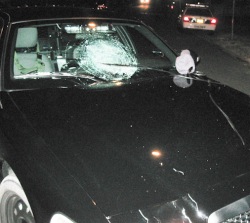
was involved in a collision with another vehicle.
(Photos: Washington County Sheriff’s Office)
A collision in Aloha (about 11 miles west of downtown Portland) last night led to minor injuries and the arrest for 44-year-old Christopher Shostak. Shostak was operating his bicycle on a residential street when he became involved in a collision with a patrol car operated by a Washington County Sheriff’s Deputy.
According to the Sheriff’s Office, Shostak was bicycling eastbound on SW Blanton Road at 7:49 pm (about 30 minutes after sunset). The patrol car was headed in the opposite direction and then turned left into SW Pinewood Place. Here’s what the official police statement (titled, “Bicyclist Arrested After Crashing Into Patrol Car”) says happened next:
“It was reported that as the Sheriff’s Deputy was turning onto SW Pinewood Place, the bicyclist ran into the front of the patrol car.”
“Generally at night we expect to see lights… If someone doesn’t have lights on they lose their right of way.”
— Sgt. David Thompson, Washington County Sheriff’s Office
Shostak was thrown over the hood of the car and the impact smashed the windshield and damaged the car’s front grill. The statement also says that Shostak wasn’t wearing a helmet, didn’t have any lights on his bicycle “as required by Oregon law,” and that alcohol “may be a factor” in the collision.
After being treated at a local hospital, Shostak was arrested and lodged in County Jail for an outstanding warrant.
Sounds like an open and shut case right?
But what the police statement doesn’t mention is whether or not the Sheriff Deputy’s car made an illegal left turn prior to colliding with Shostak. As a Google Maps Streetview image shows, there are no stop signs or signals at the intersection. It would also appear that Shostak had the right of way if he was traveling eastbound and the Sheriff’s Deputy was turning left.
Even if, as the police allege, Shostak had been drinking and didn’t have a front light on his bike (which would put him in clear violation of Oregon Law — you must have a front light visible from 500 feet during “limited visibility conditions”), what about the left turn? If you turn left and hit someone, it seems a charge of unsafe left turn or failure to yield might be warranted.
This incident brought up some questions for me: Did the Deputy make an unsafe left turn? Did he signal his intentions prior to the turn? Was he distracted? Does it matter?
I asked Washington County Sheriff’s Department spokesman David Thompson for more information.
Thompson wasn’t aware of the details in this collision, but he said that, “Most of the responsibility of the driver is gone if a car or bike didn’t have any lights on… Generally at night we expect to see lights… if someone doesn’t have lights on they lose their right of way.”
That was news to me. I didn’t know that a traffic violation by one party in a collision could absolve a violation by the other party.
Bike law expert and lawyer Mark Ginsberg says Thompson is partially right, but it’s not quite that black and white. Ginsberg says it’s possible for two parties in a crash to share fault. “It’s not always all or nothing,” he said this morning, “A jury or judge could look at it and say the driver is at fault for hitting the other vehicle, but the bicyclist is also 25% at fault, or whatever the case may be.”
I hope to hear back from Sgt. Thompson. He said he’d look further into my questions about the left turn. I’ll update this post when I know more.
UPDATE, 9/21 at 8:31: Here’s a follow-up statement from Sgt. Thompson after getting clarification from the Beaverton PD Traffic Division:
“The driver of the car has the obligation to yield the right of way on a left hand turn to oncoming traffic. At night, a vehicle/bicycle with no lights is basically invisible and in the left turn drivers mind there is no vehicle to yield to. The left turn driver can not be held responsible for not yielding to an invisible vehicle.”

